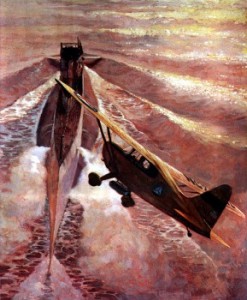What: While it takes some bravery and hours of training, recreational flying is a popular way to indulge one’s passion for taking to the sky. However for some of these pilots, flying is also a way to serve their community and save lives. The Civil Air Patrol is an all-volunteer organization that makes use of its members’ flight training and skills to help American communities by responding to area disasters. The patrol also runs several educational programs that support a better understanding of aerospace technologies for people of all ages. Recognize the important role volunteer pilots, engineers and other aviation-minded civilians play in protecting the U.S. during the Civil Air Patrol’s 70th anniversary.
Background: The Civil Air Patrol (CAP) was founded on Dec. 1, 1941. It sprang from a group of volunteer civilian pilots who used their own planes to assist in the American World War II effort, flying along the coast on reconnaissance missions and spotting submarines. After the attack on Pearl Harbor on Dec. 7, CAP greatly increased its efforts protecting the U.S. with search and rescue missions, border patrolling and disaster relief. In 1946, the patrol was recognized by U.S. law as a nonprofit organization. Two years later, Congress established CAP as an auxiliary of the U.S. Air Force, formally tasking the group with Emergency Services, Cadet Programs and Aerospace Education. Today, CAP fulfills its duties through 52 wings, one for each U.S. state as well as the District of Columbia and Puerto Rico. With more than 1,500 squadrons, volunteers participate in search and rescue missions, maintain homeland security through aerial reconnaissance, and provide support when disasters like hurricanes, tornadoes, forest fires, and even oil spills threaten lives. Additionally, CAP sponsors a cadet program to encourage leadership and education among youth, as well as an aerospace program that educates communities and schools about innovations in the field.
Story Pitch: Companies and organizations involved in the aerospace industry have a great pitching opportunity this month. Since CAP relies on civilians with an interest in aircraft, pilot organizations, flight training schools and recreational airparks may use the anniversary to attract new recreational pilots, especially the civic-minded. These organizations are also able to share how they support local CAP squadrons. Connecting with CAP’s efforts is also a good idea for aircraft and parts manufacturers, especially by supporting the patrol’s aerospace educational goals. Manufacturers can educate the public on ways their craft is used to protect local communities, and also discuss newer aircraft improvements that make missions like search and rescue safer and more successful. CAP volunteers conduct the majority of inland search and rescue operations in the U.S., and safety product manufacturers can use the anniversary to discuss better ways to prepare for and remain safe in disaster or emergency situations.
Story Hook: One of CAP’s most important duties is conducting search and rescue operations. Trained volunteers help seek out lost and missing persons in all weather conditions, saving approximately 100 lives each year. As winter moves in, snow dangers like blizzards or avalanches put many hikers, campers, skiers, and other outdoor enthusiasts at risk. What kind of training is required to help on a search and rescue mission? How can those enjoying the outdoors this winter keep prepared for these risks? How should someone signal for help, and stay safe until help arrives? Keep the following in mind as you make your pitch:
- What options are available for someone who wants to learn to fly but doesn’t want to own a plane?
- What are the requirements to earning a pilot’s license?
- How are many search and rescue operations initiated?
- How do local health organizations coordinate or assist in efforts when situations arise where commercial flights cannot operate, such as in the aftermath of Sept. 11, when flights including medical material transport were grounded?
Tips: Someone involved with CAP would be a great source to share how a passion for flying compliments a passion for helping others, while detailing the importance of the group’s work. Additionally, someone who works in emergency response can also talk about how civilian efforts like CAP are vital to saving lives in emergency situations or disasters. An aerospace engineer can speak about exciting innovations in the industry.
Resources:
Aircraft Owners and Pilots Association
(800) 872-2672
www.aopa.org
Civil Air Patrol
(877) 227-9142
www.gocivilairpatrol.com
National Institute of Aerospace
(757) 325-6700
www.nianet.org
National Association for Search and Rescue
(703) 222-6277
www.nasar.org
–Researched, compiled & written by Kristina Elliott
Event Dates & History Today from CHASE’S Calendar of Events![]()


